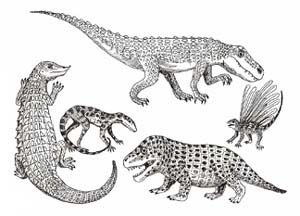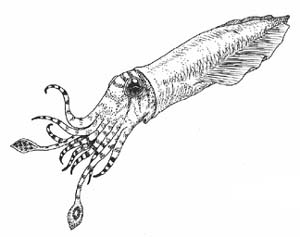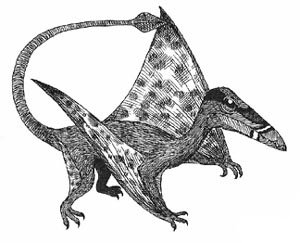Sign up for Lesson Plans, discounts & more!
The Triassic Period:
Reptiles Inherit The Earth
The Triassic Period: Life recovers From the great extinction at the end of the Permian period . How did that happen? What plants and animals survived? What else happened? Read on.
The Triassic is the first period of the Mesozoic Era. The great extinction at the end of the Permian period had brought the end to 90% of the living species on Earth. The Triassic was a time of growing new species to repopulate the planet.
A New Era
This
time was the beginning of a new era, the Mesozoic Era. Geologists call
it a new era because the life supported on the continents was so
different from life during the Paleozoic Era. During the Paleozoic, most
life had been in the sea. It was only at the end of the Paleozoic that
life had gradually moved onto land and begun to develop animal and plant
species that could live out of the water.

The Age of Reptiles
The Mesozoic Era is called the Age of Reptiles.
But that only tells a small part of the story. Just like the Paleozoic
Era, the Mesozoic is divided into periods. Each period has specific land
forms and climates, so each period has special animals and plants that
developed. The Mesozoic Era is divided into three periods: the Triassic
Period, the Jurassic Period,, and the Cretaceous Period.
The
Triassic began around 248 million years ago, after the mass extinction
that brought an end to the Permian Period. It lasted about 42 million
years. The Triassic Period ended around 206 million years ago. It had a
special climate because of the way the land was placed on the Earth. At
the beginning of the Triassic, the land was all together in one
supercontinent, Pangea. It straddled the equator, so the climate was
warm.
Pangea Was Warm and Dry
Pangea was shaped like a giant “C” with the opening surrounding the Tethys Sea. All around the outside edges of Pangea was the Panthalassia Ocean.
There were no shallow seas surrounding Pangea. The shape of Pangea kept
the Panthalassia Ocean waters from bringing cool, moist air to any
parts except the coast. This made the inland areas dry and desert-like.
Laurasia and Gondwanaland
Pangea
started to break up almost as soon as it was formed. By the middle of
the period, the continent was on its way to becoming two super
continents. The sea floor was spreading along a rift at the bottom of
the Tethys Sea. It was forcing Pangea apart. The part of Pangea above
the equator was Laurasia. It was a combination of North America
and Eurasia. As the sea floor pulled apart, Laurasia moved to the north.
The other part, Gondwana, moved to the south. It was made up of Africa, South America, India, Antarctica and Australia.
New Mountains In North America
On
the ocean side of Pangea, mountains were just beginning to form.
Volcanoes erupted where the plates were moving. One plate was being
forced under another. These were the beginnings of the Sierra Nevada
mountain range. Most of the western part of North America was under
water during the Triassic. The new mountains looked like a line of
islands in this ocean.
Many species that survived the Permian Extinction died out during the early part of the Triassic. Trilobites, bryozoans, and rugose (horn) corals all disappeared. But many new species developed. The ammonites and brachiopods survived and began to recover. One type of ammonite was especially plentiful during the Triassic Period. The suture lines are lines between the sections of the ammonite. When the suture lines formed a wavy pattern, it is called a ceratitic ammonite. There were many ceratitic ammonites in the Triassic seas.

The Belemnites
A completely new invertebrate species that
developed in the Triassic was the belemnite. Belemnites were a mollusk
that belonged to the class cephalopoda. The belemnites had no external
skeleton like their earlier relatives, the orthoceras, their relative
the ammonite. Instead, they had an internal skeleton. Squids are a
modern-day relative of the belemnite.
Reptiles Are Well Adapted To The Hot Dry Triassic
The
most important development was happening to the reptiles. These animals
would dominate the land, sea and air throughout the Mesozoic Era.
During the early part of the Triassic Period, when Pangea was still one
huge supercontinent, the reptiles were more adaptable to the hot dry
lands.
The First Dinosaurs
The cold-blooded reptiles seemed to live better in the desert-like land environment than the Therapsids,
or mammal-like retiles. Many different species of the cold-blooded
reptiles developed during this time. Also, the first dinosaurs
were evolving. The dinosaurs were different from the reptiles.
- First, they were warm-blooded. This means the temperature of their blood was kept constant inside their body instead of changing with the outside temperature.
- Second, their bone structure was different in the hips, legs and hands.
Most dinosaur species lived after the Triassic Period. They would come to dominate the Jurassic and Cretaceous periods.
Mammals First Appearance
Another land animal developing
around the same time as the dinosaurs were the mammals. These mammals
were very small. They weren’t very important until millions of years
later in the Cenozoic Era.
Reptiles Rule the Triassic Seas
There
were many reptiles living in the Triassic seas. Ichthyosaurs developed
in the Triassic period. They had a fish-like body so would have spent
their life in the seas. But, they breathed with lungs and did not have
gills. The plesiosaurs also developed during the Triassic. Like the
ichthyosaurs, they would grow in numbers through the Jurassic and
Cretaceous periods.

Reptiles Take To The Air
The end of the Triassic period saw
flying retiles develop. These animals were called pterosaurs. Most of
the species of this group became important in the Jurassic and
Cretaceous periods. The flying reptiles were not relatives of birds. In
fact, dinosaurs are more closely related to modern birds.
Conifers and Ginkgos Replace Ferns and Lycopods
During
the late Permian Period, or Pennsylvanian Epoch, the coal swamp plants
were the most important. These tree-ferns and lycopods could not live in
the dry climate of the Triassic Period.
Instead, the conifers and ginkgos survived the Permian extinction and developed during the Triassic. The evergreen plants were much more able to cope with the dry climates.
Minor Extinction
Many
of the important species of both plants and animals got their start
during the Triassic Period. It was a time of transition. The few species
that survived the Permian mass extinction were growing into new
species. The extinction that marked the end of the Triassic Period
seemed small compared to the one that ended the Permian Period. Only
about 20% of life in the oceans and on land died out completely. The
species that were affected came back with strength and would soon
dominate the world of the Jurassic and Cretaceous Periods.
Before The Triassic Period was the Permian Period
Check out some of the Educational Materials for sale on our sister site fossilicious.com.

interested in more? If so, you may want to check out our other sites:
fossilicious.com - Our online fossil and mineral rock shop.
rocksandminerals4u.com - An educational site about rocks, minerals, and geology.
Geologic Time Geologic Time Line
Cenozoic Era
Quaternary
Neogene
Paleogene
Mesozoic Era
Cretaceous
Jurassic
Triassic
Paleozoic Era
Permian
Carboniferous
Devonian
Silurian
Ordovician
Cambrian
Archean Time
Hadean Time
Teachers Resources
Activities for Education and Fun
Earth Science Lesson Plans
Activities For Kids
Fossil Lesson Plans
Fossil Activities
Education Articles
Coloring Pages
Dinosaur Coloring Pages
Montessori Materials
Geology Club
Fossil Hunting
 |
 |
 |




